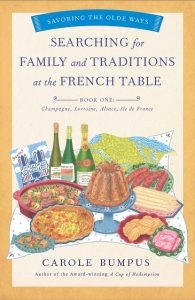Under Grandma’s Table
UNDER GRANDMA’S TABLE

Photo by Chris Loomis
It was summertime 1926—a hot steamy night in western Kansas. Peering out from under the table, she looked around her grandmother’s kitchen. Seeing only the bottom half of things—the pie cupboard with the tiny bird-designs tapped into the tin front, the squat legs of the cast-iron stove, the open back door sending a slight breeze into the over-heated room, and the spindle chair legs which pressed up close to her, as she remained hidden under the kitchen table.
Wedged around her were the legs of her family—favorite Aunt Hazel, stalwart Uncle Glen, teasing and testy Uncle Kenneth, plus Grandma, and her Dad and Mom. All were there. Difficult as it was at age five, she remained quiet, melting into a puddle of sweat at their feet, grateful they had forgotten she was hiding there.
Laying her cheek onto the coolness of the linoleum floor, she giggled as hilarity rocked the table. The voices above rose and fell, one after the other, like combatants in a war of words. One joke, then another, one raucous story followed another… and then, laughter would spike the air above. She could make out the chortles from her strait-laced grandmother; the timid glee of her aunt; the gut-wrenching bellows of Uncle Glen; and the quiet amusement from her own father, as her mother’s sighs of disgust filtered down to her ears.
And then, it began all over again. Attempting to outdo each other, they repeated stories they’d read; jokes they’d heard; poems they’d memorized; and, of course, the height of the evening were anecdotes made up on the spur of a challenge. Every night was the same; something a body could count on. The rich banter, the lightning-quick repartee, the good-humored jibes—all were like salve on the sunburned skin of my mother’s childhood.
“Always the stories,” my mother recounted to me and my siblings years later. “We always had stories.” Therefore, my life, too, was formed by stories. The experience of families coming together, sitting down at the table, eating hearty meals of meat and potatoes, but knowing the mirth that would follow was the dessert everyone loved best.
My mother was raised in Herndon, Kansas—way out on the ‘prairies’ as they used to call them. She said, they called it ‘Little Europe’ because people came from all over Eastern and Western Europe during the land grab days. She said her neighbors spoke German, Polish or had an Irish brogue which she loved best. She remembered being invited into their homes and seeing pitchers of beer sitting right on their kitchen table—available for anyone to drink. Growing up in a strict Quaker household, having beer was considered a sin. So, of course, it held a magical appeal.
Mama told us five kids she was full Irish—and we never questioned it—until we were told differently after she died. We had gathered up her imagined heritage and had worn it like it belonged, all because she had loved it so. And, it became her. Those laughing Irish eyes, the rich wit, her eagerness to tell and listen to an enjoyable yarn, plus the laughter. So, it became a part of us, too!
“Laughter and talk in the good times; laughter and talk in the bad times,” she would say. She had learned that very lesson under her grandmother’s table.
My father, on the other hand, was a 100% Swede. No quarters or halves about it! 100%! No wonder Mama kept secret she was only part-Irish. As for my dad, I was a teen before I realized that ‘damnstubbornSwede’ was more than one word. He was a force to be reckoned with. But coming from a big family, the enjoyment of home-cooked food at the table, plus an opportunity to share humorous ‘shaggy-dog stories’ was also his idea of a fine time.
Just after World War II, while I was a little tyke, my folks, sister and I moved into my paternal grandparent’s basement apartment in Kearney, Nebraska. Every morning, I would smell the aroma of Swedish coffee plus the hot-out-of-the-oven Swedish rye bread my grandmother was baking, come wafting down the stairs to greet me. Before my mother could have her say, I would go clomping up the basement stairs in my high-top Buster Browns to greet the morning at my own grandmother’s table. Yup! There I would be—perched on top of a dozen books piled onto a kitchen chair—and I would begin my second breakfast of the day. With my feet dangling off the chair, my napkin stuffed under my chin, I would sit next to my Grandpa as I would begin the cultural ritual of slurping coffee from my own little cup while digging into a hot, thick, dark brown slice of rye bread with butter melting down—simply oozing onto my—ah, but, I digress.
Well, actually, maybe I didn’t, because this is what brings me to you—sharing the inspiration which led me to write this series—Savoring the Olde Ways—about families, traditions, favorite foods, and, most of all, shared stories whether at the kitchen table—or underneath it.
—
A retired family therapist, CAROLE BUMPUS began writing about food and travel when she stumbled upon the amazing stories of women and war in France. She has traveled extensively throughout France and Italy, where she has interviewed more than seventy-five families to date for her food and travel blogs. Her historical novel A Cup of Redemption was published October 2014, and her unique companion cookbook, Recipes for Redemption: A Companion Cookbook to A Cup of Redemption, was released August 2015, both by She Writes Press. She is an active member in the California Writers Club and through them has also had three short stories published in the Fault Zone anthologies: Words from the Edge, Stepping up to the Edge, and Over the Edge. Bumpus lives in the San Francisco Bay Area. Visit her website at CaroleBumpus.com.
https://www.goodreads.com/
Searching for Family and Traditions at the French Table, Book One
 Part culinary memoir and part travelogue, Carole Bumpus gathered this compilation of intimate interviews, conversations, stories, and traditional family recipes (cuisine pauvre) in the kitchens of French families as she traveled throughout the countryside.
Part culinary memoir and part travelogue, Carole Bumpus gathered this compilation of intimate interviews, conversations, stories, and traditional family recipes (cuisine pauvre) in the kitchens of French families as she traveled throughout the countryside.
Travel with her through Champagne caves/wineries and historic cathedrals, local farmers’ markets, ancient potters’ guilds, and restaurant kitchens with wood-fire ovens.
Learn how to make homemade Spinach-stuffed Tortellini with Bolognaise Sauce from the Champagne region, Crêpes and Watercress-stuffed Ravioli from the Lorraine, and Baekeofe and Kugelhopf from the Alsace. “Go blind” from the family stock of Eau de Vieliqueur and be treated to tales of foraging for snails for the infamous and now extinct Escargots Festival. And, on a somber note, listen to accounts of families forced from their communities during the German occupation of WWII in the Alsace and Lorraine, only to continue to struggle for survival after finally making their way home.
Category: Contemporary Women Writers, How To and Tips






























